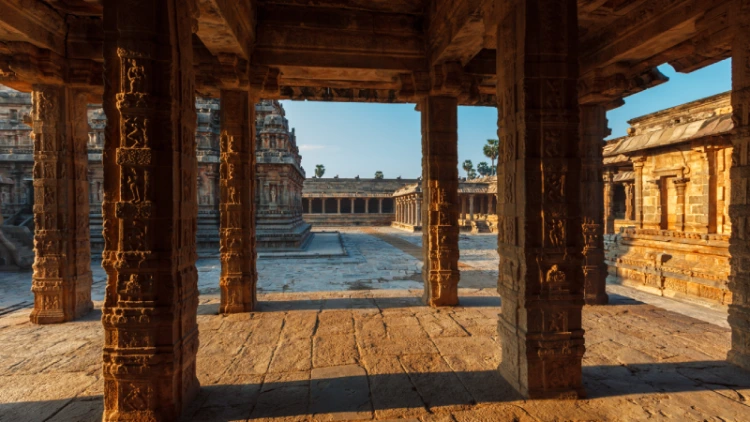Hampi, often referred to as the Lost City, is a place where history, culture, and nature converge in a breathtaking landscape. Once the flourishing capital of the Vijayanagara Empire, Hampi is now a UNESCO World Heritage Site that attracts history enthusiasts, photographers, and travelers from around the world. In this post, I’ll take you on a journey through Hampi’s rich history, its rise and fall, and the legacy it left behind. Let’s uncover the secrets of this ancient city and explore why it continues to captivate visitors even today.
The Rise of the Vijayanagara Empire
Founding of the Empire
The Vijayanagara Empire was founded in 1336 CE by two brothers, Harihara I and Bukka Raya I, under the guidance of their guru, Vidyaranya. The empire was established to resist the invasions of the Delhi Sultanate and to protect the cultural and religious heritage of South India.
The Golden Age
The empire reached its zenith during the reign of Krishnadevaraya (1509–1529), one of its greatest rulers. Under his leadership, the empire expanded its territory, fostered art and literature, and built some of the most magnificent temples and structures in Hampi.
Key Achievements
- Architectural Marvels: Construction of iconic temples like the Vittala Temple and Virupaksha Temple.
- Cultural Flourishing: Promotion of literature, music, and dance.
- Economic Prosperity: Establishment of trade routes with foreign countries, including Persia and Portugal.
The Glory of Hampi
Hampi as the Capital
Hampi, then known as Vijayanagara, served as the capital of the empire. It was a thriving city with a population of over 500,000 people, making it one of the largest cities in the world at the time.
Key Features of the City
- Temples: The city was home to numerous temples, each showcasing the empire’s architectural brilliance.
- Markets: The bustling markets of Hampi were known for their trade in precious stones, spices, and textiles.
- Infrastructure: The city had well-planned streets, water management systems, and public buildings.
Architectural Highlights
- Vittala Temple: Famous for its stone chariot and musical pillars.
- Virupaksha Temple: One of the oldest functioning temples in India.
- Royal Enclosure: The administrative and ceremonial hub of the empire, featuring structures like the Mahanavami Dibba and Stepped Tank.
The Fall of the Vijayanagara Empire
The Battle of Talikota
The empire’s decline began with the Battle of Talikota in 1565 CE, where the Vijayanagara forces were defeated by a coalition of Deccan Sultanates. The city of Hampi was plundered and left in ruins, marking the end of the empire’s golden age.
Aftermath
- Destruction: The once-thriving city was reduced to ruins, with its temples and structures left in disrepair.
- Abandonment: Over time, Hampi was abandoned and reclaimed by nature, earning it the title of the Lost City.
Rediscovery and Preservation
Rediscovery by the British
Hampi remained hidden for centuries until it was rediscovered by the British in the 19th century. Archaeologists and historians began to uncover its ruins, revealing the grandeur of the Vijayanagara Empire.
UNESCO World Heritage Site
In 1986, Hampi was declared a UNESCO World Heritage Site, recognizing its cultural and historical significance. Efforts have since been made to preserve and restore its ruins, ensuring that future generations can appreciate its legacy.
Exploring Hampi Today
Top Attractions
- Vittala Temple: Known for its iconic stone chariot and musical pillars.
- Virupaksha Temple: A spiritual hub with a towering gopuram and vibrant rituals.
- Royal Enclosure: Home to the Mahanavami Dibba, Stepped Tank, and Queen’s Bath.
- Hemakuta Hill: Offers panoramic views of Hampi’s landscape.
- Tungabhadra River: A serene spot for coracle rides and reflections of the ruins.
Cultural Significance
- Festivals: Hampi Utsav, Virupaksha Car Festival, and Purandaradasa Aradhana celebrate the city’s heritage.
- Local Culture: Traditional handicrafts, music, and cuisine reflect the region’s rich cultural traditions.
Why Hampi Continues to Captivate
A Living Museum
Hampi is more than just a collection of ruins; it’s a living museum that tells the story of a glorious past. Every stone, every carving, and every structure has a story to tell, making it a fascinating destination for history buffs and travelers alike.
A Photographer’s Paradise
The dramatic landscape of boulders, temples, and rivers makes Hampi a paradise for photographers. Whether you’re capturing the intricate carvings of the temples or the serene beauty of the Tungabhadra River, Hampi offers endless opportunities for stunning shots.
A Spiritual Retreat
For those seeking spiritual solace, Hampi’s temples and serene landscapes provide the perfect setting. The peaceful ambiance and the vibrant rituals offer a chance to connect with the divine and find inner peace.
Tips for Visiting Hampi
Best Time to Visit
- October to February: Pleasant weather, ideal for exploration.
- Avoid Summer: March to May can be extremely hot.
How to Reach
- By Air: The nearest airport is in Hubli (144 km).
- By Train: The nearest railway station is in Hospet (13 km).
- By Road: Well-connected by buses and private vehicles.
Accommodation Options
- Hampi Bazaar Area: Budget guesthouses and homestays.
- Hospet: Mid-range and luxury hotels.
Local Transportation
- Bicycles: Ideal for exploring the Royal Enclosure Area.
- Auto-Rickshaws: Convenient for short distances.
- Scooters/Motorcycles: Rent a scooter for more flexibility.
Final Thoughts
Hampi is a destination that offers a perfect blend of history, culture, and natural beauty. Whether you’re exploring its ancient ruins, participating in vibrant festivals, or simply soaking in the serene landscapes, Hampi has something for everyone. So pack your bags, grab your camera, and get ready for an unforgettable journey through the heart of Karnataka’s most iconic destination.

